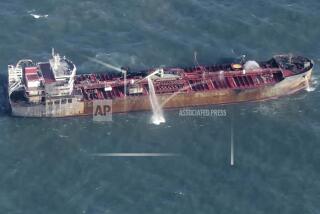SPILL AT A GLANCE THE SPILL
- Share via
Ship: American Trader.
Oil spilled: Nearly 400,000 gallons, Southern California’s biggest in two decades.
When: About 4:30 p.m. Wednesday.
Where: Washing ashore along a 14-mile stretch as far north as Seal Beach. Several fingers of the slick were within two miles of Long Beach.
Ocean depth: As little as 50 feet in some spots in the sea berth, 60 feet or more in area where ship maneuvers.
How: Coast Guard suspects the ship ran over its port anchor while maneuvering into a U-shaped nest of seven mooring buoys off Huntington Beach. As crew pulled up anchor, it apparently wrapped around bow and put two holes and a dent in the starboard bottom of hull. Ship also may have hit sea bottom, causing anchor to puncture hull.
The slick: At least 60 square miles. About 10% of the oil was recovered by skimmer boats.
Oil left: Damaged tank still contains more than 19.32 million gallons of oil, but it apparently is not leaking. Steel and wood patches are likely to be placed over the two holes in the tanker by early this week.
THE SHIP
Built: In 1969 by Sun Shipbuilders and Drydock Inc. of Philadelphia, now defunct. Named America Sun. Acquired by American Trading Transport Co. Inc. on July 11, 1989, and renamed American Trader. Chartered by British Petroleum Co. of North America, which was operating it at time of spill.
Width: 125 feet.
Length: 800 feet.
Hull depth: 42 or more feet below water surface at time of incident.
Anchor: More than 10 feet long.
Oil capacity: 23 million gallons. More than a dozen tanks, some of them for ballast and ship waste. Fully loaded at time of incident.
Itinerary: Planned to unload more than 12 million gallons at the sea berth, where a pipeline connects to a Santa Fe Springs Refinery. The rest was to be delivered to the Port of Long Beach.
THE CLEANUP
Offshore: At least 13 skimmer boats are on scene. Coast Guard was also there to monitor operation.
Beaches: As oil comes ashore, cleanup crew in slickers use absorbent pads on sand. More than 500 workers were scheduled to be involved in the cleanup by today.
Preventive measures: Rubberized booms have been set up to keep oil from estuaries at Bolsa Chica State Reserve, Anaheim Bay, Upper Newport Bay and Santa Ana River.
Options: Officials have ruled out chemical dispersants, which break up the slick. Dispersants can reduce the chance that oil will wash ashore but cannot be used in shallow areas because of possible toxic effects on bottom-dwelling organisms, fish or shellfish.
Birds: Sixty-six oil-covered shore birds washed up after spill, 31 of them dead. If slick reaches Bolsa Chica wetlands at north end of Huntington Beach, it could be devastating to one of California’s largest ecological reserves. California brown pelican, California least tern, the light-footed clapper rail and the salt marsh bird’s beak, an upper marsh coastal plant, are endangered species in the wetlands.
Other wildlife: One dead sea lion washed ashore in Huntington Beach Saturday night, but it was unclear late Saturday whether oil caused the death. The oil could take a deadly toll on fish and perhaps marine mammals such as sea lions. Oil mats mammals’ fur, making them susceptible to cold and less buoyant. About 30 seals were spotted Friday on mooring buoys near the tanker but apparently were unharmed. More critically endangered may be tiny links in aquatic food chain--anchovies, mussels and barnacles.
Source: U.S. Coast Guard, Times staff
More to Read
Sign up for Essential California
The most important California stories and recommendations in your inbox every morning.
You may occasionally receive promotional content from the Los Angeles Times.












